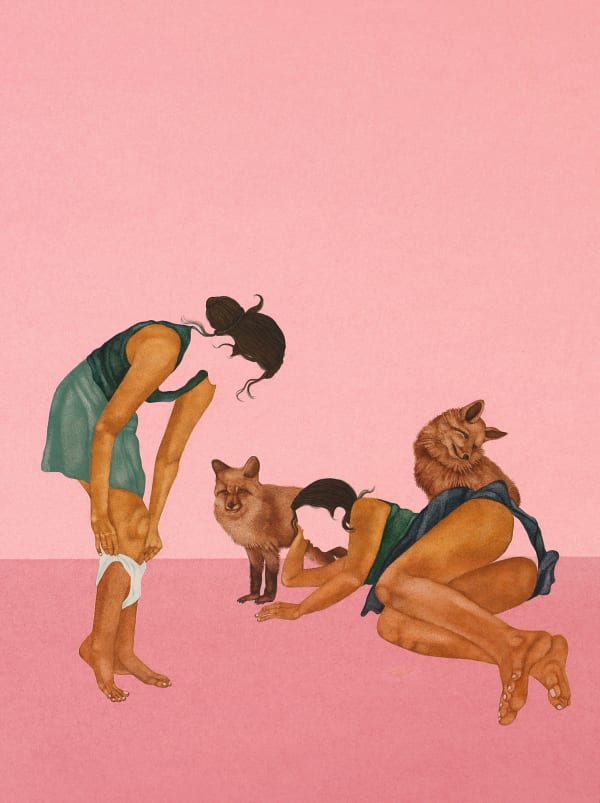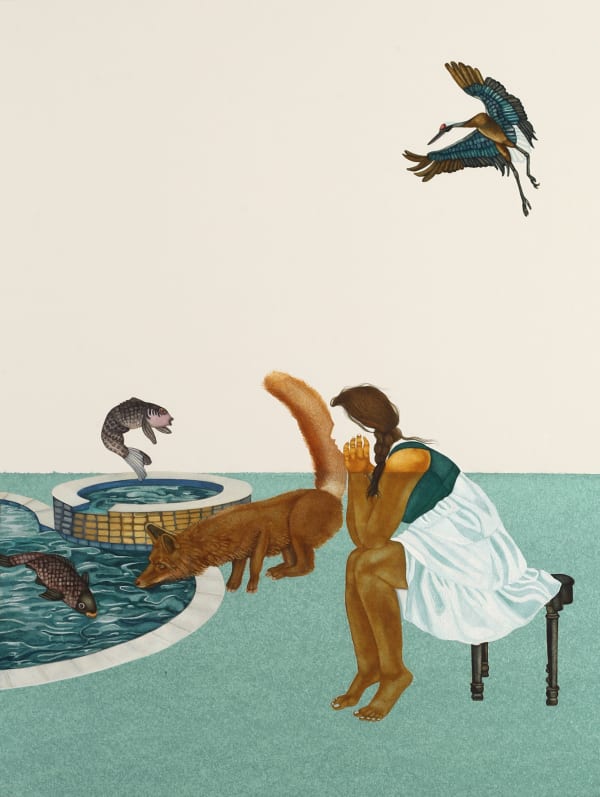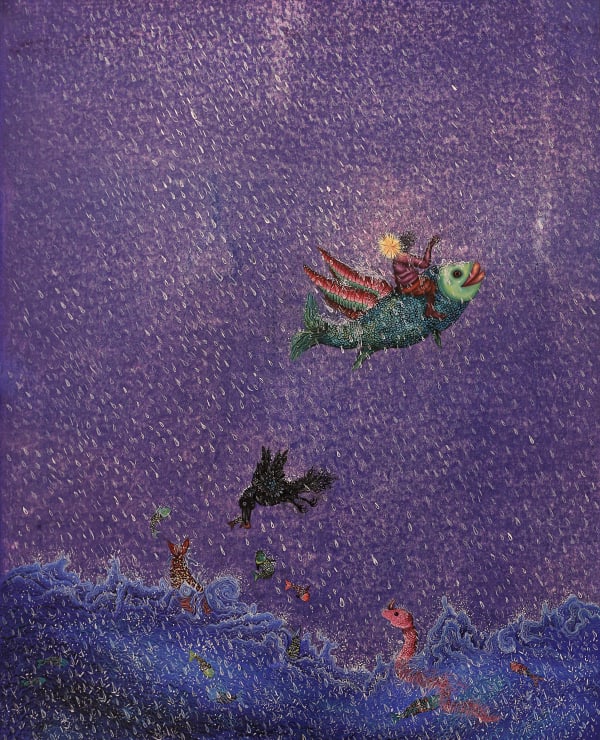-
Internal Landscapes
Rabia Farooqui & Rabia S. Akhtar -

-
Solo Exhibitions include (Upcoming) Internal Landscapes, Kristin Hjellegjerde Gallery, Berlin, Germany (2023); Two Adults and an Attachment, Kristin Hjellegjerde Gallery, London (2021); Baby, You’re A Metaphor, O Art Space, Lahore, (2018); Clap Clap- I Approve!, Sanat Art Gallery, Karachi, (2017).Group Exhibitions include Group Show, Galerie Isa, Mumbai, India (2022), Amad, O Art Space, Pakistan (2022); Art Dubai 2022, Dubai, UAE (2022); Two Person Show, O Art Space, Pakistan (2022); Interconnected, John Wolf, Los Angeles, USA (2021); Facing The Sun, Schloss Goerne, Germany (2021); Peculiar Speculations, O Art Space, Lahore, Pakistan (2021), Devil's in the Detail, Kristin Hjellegjerde Gallery, London (2020); Full Circle Gallery, Karchi, Pakistan O Art Space Gallery, Lahore, Pakistan (2020); Drawing Room Diamonds Inflated Vocabulary, Sanat Art Gallery, Karachi (2019); Augmentation, US Consulate, Karachi (2018); Beneath the Surface, Canvas Gallery, Karachi (2017); Carte Blanche, Fomma DHA Art Centre, Karachi (2016).Highlight, nominated for the Sovereign Asian Art Prize (2020).
-

-
Group exhibitions include (Upcoming) Internal Landscapes, duo exhibition with Rabia Farooqui, Kristin Hjellegjerde Gallery, Berlin, UK (2023); O Art Space, Lahore (2022), Canvas Gallery, Karachi (2022); LBF Virtual Museum 'The Body and Beyond: Women's Movements in Pakistan', Lahore (2022), Dar-Aamad, O Art Space, Lahore (2022), What is a Good Painting, Art Chowk Gallery, Karachi (2022), Khat-o-Kitabat, Koel Gallery, Karachi, and O Art Space, Lahore, (2021), Breathing Light, Koel Gallery, Karachi (2021), The Architecture of Being, AAN Art Space & Museum, Karachi (2021), Microcosm 4, AAN Art Space and Museum, Karachi, March (2021), Past, Present, Future, Koel Gallery, Karachi (March 2021), Pretty Art for Pretty People, Sanat Initiative, Karachi (2020), Being Human, O Art Space, Lahore (2020), Every Road is a River, Ministry for Gozo, Gozo, Malta (2020), Echoes of the Walls, Vasl Artists’ Collective, Karachi (2020), Artist Statement 5, Czong Institute for Contemporary Art (CICA) Museum, Gimpo, South Korea (2020), Rehai, VM Gallery, Karachi (2019), Rhythms of Resurgence, Koel Gallery, Karachi (2019), Not Just the City, Space B, Spazju Kreattiv, Valletta, Malta (2018), Beneath The Surface, Canvas Gallery, Karachi (2017), We Ate The Birds, Koel Gallery, Karachi (2017), Who Killed Shumaila, Sanat Gallery, Karachi (2017), Ibtidaa, Studio Seven Gallery, Karachi (2016), Carte Blanche, Fomma Trust, Karachi (2016), Awaken Our Legacy, Standard Chartered Bank, Karachi (2016), Pehli Manzil, Karachi (2016), Indus Valley School of Art and Architecture Thesis Show, IVS, Karachi (2015).RESIDENCESRabia S. Akhtar received the 2020 Residency of Taaza Tareen 12, Vasl Artists’ Association, (Art Writer in Residence), Karachi, Pakistan. Furthermore she was part of the Locating Word - Art Writer’s Residency, Vasl Artists’ Association, Karachi, Pakistan. In 2018, she was the recipient of the Valletta 2018 Artist-in-Residence Program, Gozo, Malta.
-
Internal Landscapes
Where do we draw the line between reality and the stuff of dreams? Internal Landscapes, a duo exhibition of miniature paintings by Rabia Farooqui and Rabia S. Akhtar at Kristin Hjellegjerde gallery in Berlin, brings together hybrid beasts and luminescent landscapes, slumbering faceless figures, floating fish and green translucent pools of water. These are scenes of the imagination – alternately strange and seductive, luscious and bare.Farooqui’s practice explores the ways in which we express ourselves and relate to one another, often in a performative nature. In previous works, her figures appeared almost like puppets with their limbs carefully constructed around objects and animals within a coloured space to create highly theatrical scenes. Here, however, she takes a more introspective focus. Her figures are slumped over, their heads hanging and limbs heavy in postures that evoke if not quite sleep, then inertia. Are they peacefully snoozing or unconscious? And what of the rising wash of colour in which some appear partially submerged – are they bathing or drowning? For Farooqui, this ambiguity reflects the sleep state whereby our physical body is motionless, tethered to the real world, while our mind journeys through fantastical realms. ‘When we are asleep, we are able to access different parts of our consciousness while our body recharges but at the same time, it is a very vulnerable state to be in, a kind of in-between,’ she says.Within this limbo space, Farooqui also explores the duality or multiplicity of self, visualised through two characters which appear side by side but separate. Their body language is often energetically at odds (one character may be standing, for example, while the other is sitting), representing the push and pull that we each experience between our different emotions and impulses. This is perhaps most clearly seen in Balancing act in which one character is curled up on the ground while the other has created a bridge posture over the top of her, with one leg suspended in the air, providing a perch for a bird. On the left-hand side of the painting, two fish mimic these postures, capturing the subtle shifts and tensions between interior mental space and exterior physicality. In this way, Farooqui builds a connection between the animals and the figures that creates a visual harmony while also pointing at the latent sense of threat that runs throughout the series. Here as in other works, the fish appear out of water, their bodies unnaturally contorted in a symbol of helplessness, while in another painting, we see a wolf crouched as if hunting the fishing swimming in a pond. These narratives – or potential fissures – work with rather against the delicate brushstrokes, soft colour palette and paradisal connotations of the garden-like setting to deliberately muddy the distinctions between emotional states, movement and stillness, conscious and unconscious worlds.Akhtar’s paintings, by contrast, are much denser in detail and colour, populated with mythical, hybrid creatures. As a child growing up in Karachi, the artist very rarely came into contact with animals though she was fascinated by the creatures of Urdu fables, cartoons and folk tales and began to construct her own fantastical world where she could encounter them more intimately. As she grew older, however, and learnt more about endangered wildlife and the ways in which the human world has intruded on the animal kingdom, she had to find a way of reconciling her dreams with the harsher realities. Her paintings are the point at which the two worlds meet: the rich, fertile territory of the imagination and the more barren visions of pollution and destruction. Remains of a Forest, for example, appears at a first glance to depict a magical ecosystem filled with colour and life, but as we look more closely the landscape takes on an almost radioactive glow while a large pink fish lying within grass appears sickly and mutated, blowing out smoke instead of bubbles. A single flower on fire and the heads of three dragons emerging from the foliage with gnashing teeth add to the sense of threat and precarity.Many of the paintings also contain bearded men that are wearing animal masks or have taken on animal characteristics and have colouful, almost slug-like, oozing bodies. In Remains of a Forest, this figure appears to be attempting to blend in with his surroundings, partially hidden behind palm leaves, but the buffalo head mask and his furry butterfly wings only serve to highlight his difference. Like the fish in the grass, he is painfully at odds with the environment. In Lost Crow, he is similarly conspicuous, sitting astride a giant, winged fish that’s flying through a rainstorm as a crow swoops to pluck a smaller fish from the waves beneath them. ‘These people,’ Akhtar says, ‘represent human surveillance and the ways in which humans have invaded and altered the animal world.’ Though these men appear other-worldly, the notion of incorporating animal parts into the human body exists in the everyday: we apply beeswax to our lips and cosmetics that contain crushed oyster shells in the hope of more luminous skin. In Pakistan, Akhtar notes, people pay to hunt a bird known as the Houbara bustard which is thought to be an aphrodisiac when consumed. ‘I am interested in the ways in which we seek to become more like animals and use them for our benefit,’ she says. ‘The men in my work have become monsters but they never truly gain access to the animal kingdom – they’re stuck outside of it, however much they try.’This element of desire is conveyed through the bright colours and the glistening sheen of the animals, but for Akhtar the paintings are less about nostalgia and more about bridging the gap between childhood fantasy and adulthood. At the same time, she acknowledges that her work is still a form of necessary escapism: it provides her with a safe space, simultaneously connected to and detached from reality, within which she can negotiate her emotional response to the world.Displayed together, Farooqui and Akhtar’s paintings create a vivid visual dialogue that seems to spill out of the confines of the canvas to reverberate through the space that surrounds them. Weaving together fact and fiction, the visible and the imagined, these are works that celebrate art as a form of solace and revelation. -
Internal Landscapes: Rabia Farooqui & Rabia S. Akhtar
Past viewing_room















